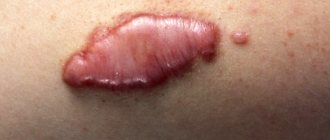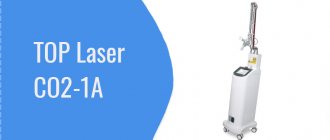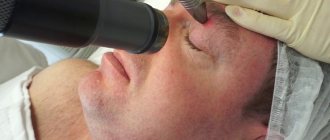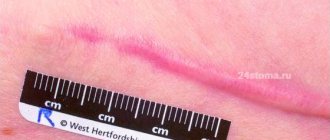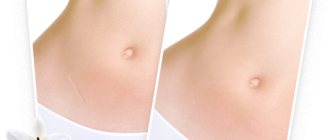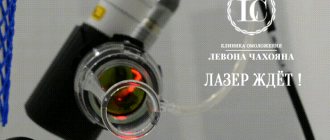- Causes of scars
- How to get rid of scars and scars without surgery
- How to remove scars and scars surgically
- Rehabilitation after scar excision
- Effect of the procedure
Scar formation is a normal reaction of the skin to a violation of its integrity. After minor injuries, only a light strip remains, but larger skin injuries form pronounced, clearly visible defects. Such scars and scars require treatment.
How does the skin heal after surgery?
Scars are part of the healing process. They can form after surgery or if you cut yourself or otherwise damage your skin.
After surgery or a procedure, the wound may be bright red, swollen, or numb. After a few weeks, the developing scar may be hard to the touch, tight, raised, or lumpy. Over time it will become softer and smoother and less red. The healing of the scar after surgery will continue for 12–18 months.
to come back to the beginning
Causes of scars
Surgeries, cuts, burns, pustular skin lesions and any other injuries damage the epidermis, forming a wound. The body seeks to close this wound by filling the defect with connective tissue. Moreover, this tissue has quite a few cellular elements; it is a mixture of randomly located molecules of collagen, elastin, other proteins and biological substances.
Of course, such tissue is very different from normal skin, which has a cellular structure. The scar has a much denser and rougher texture, reduced elasticity, whitish or, conversely, a bluish, purple tint. In addition, it lacks nerve endings, sebaceous glands and hair follicles.
Scar care at home
Scars don't go away completely, but you can improve their appearance and reduce the discomfort they cause. Before following the recommendations below, talk to your dermatologist (skin doctor). In most cases, patients can begin performing them approximately 4 weeks after surgery.
Protecting Scars from the Sun
Exposure to sunlight can slow down scar healing. In addition, the scar may darken and become more visible.
It is important to protect the rumen when you are outdoors or when it may be exposed to sunlight. You can resort to the following measures:
- Apply sunscreen to the scar. Use a broad-spectrum sunscreen with a protection factor (SPF) of at least 30.
- Wear a hat with a wide brim to block out sunlight.
- Wear clothing designed to protect you from sunlight.
For more information about using sunscreen, see Understanding Sunscreen. You can find it through the search function on our website mskcc.org/pe or ask your nurse.
Scar massage
Massage can make the scar less hard. Gently massage the scar with your fingers for 1-2 minutes. You can do this 1-3 times a day.
Use of silicone products
Silicone products, such as silicone sheets or gels, can moisturize the scar and promote healing. You can use them under makeup and clothes.
Silicone wafers
Silicone sheets will help soften the scar and make it flatter.
To use a silicone plate, you need to cut it to the size of the scar and place it on top of the scar. You can leave the plate for several hours or overnight. You can wash the plate daily and reuse it. Silicone wafers are available under brands such as Cica-Care®, Rejuveness®, Scar Fx® and ScarGuard®, among others.
Silicone gels
Apply silicone gel to the scar and let it dry. You can do this daily. Silicone gels are available under brands such as Biocorneum®, Kelo-cote®, Mederma® and ScarGuard, among others.
Applying makeup
To hide a scar, you can apply a special makeup called camouflage. Thanks to camouflage makeup, the color of the scar will match the natural color of the skin. Camouflage makeup is produced, in particular, under such trademarks as Dermablend® and SmartCover®.
To make the red scar blend better with your skin color, you can also try applying green makeup to it.
to come back to the beginning
Healing of postoperative scars
Let's start by discussing the first group. After the surgeon has removed the sutures, the surgical area needs speedy healing, the formation of the “correct” scar and the prevention of pathological scars, and the patient’s body needs to restore physical and psycho-emotional strength. Therefore, it is necessary to include procedures that accelerate regeneration.
Plasma therapy takes the lead . Our own plasma enriched with platelets is a powerful stimulus for healing because it contains a large number of growth factors that are responsible for regeneration in our body. Plasmolifting stimulates the formation of healthy collagen and elastin, activates local skin immunity, improves microcirculation and cellular metabolism.
In second place is placentotherapy . The drugs Melsmon, Laennec and Curasen activate the immune system response, which allows the formation of a more aesthetic scar in a shorter time. The placenta increases cellular and tissue respiration, increases the metabolic activity of the body's cells, stimulates the processes of regeneration and self-regulation, and increases the body's adaptive capabilities. Placental preparations have a pronounced antioxidant and anti-inflammatory effect, protect the body from the effects of adverse environmental factors, restore impaired homeostasis, and increase the body's defenses.
Mesotherapy takes bronze . In the early postoperative period, meso-cocktails are used to improve microcirculation and healing and prevent the formation of coarse fibrous tissue. The list of such mesopreparations is large, we will list the main ones: hyaluronic acid, gingo biloba, Rutin, organic silicon, panthenol, DMAE, coenzyme Q10, arnica extracts, witch hazel and others.
Autohemotherapy can also be noted as an adjuvant . The latter, in turn, accelerates reparative processes, improves metabolic processes in the body, increases immunity, improves blood and lymph flow, restores performance and vitality.
Medical treatment of scars
There are also medical treatments that can make the scar look better and cause less discomfort. Examples of such treatments include:
- steroid injections (shots);
- dermabrasion (surgical scraping of the upper layers of skin);
- laser treatment;
- operation.
These treatments may be used after the scar has healed sufficiently on its own.
Your dermatologist will tell you whether any of them are right for you. to come back to the beginning
Keloid and hypertrophic scar
Our practical experience (more than 500 operations to correct rough scars after unsuccessful operations performed in other clinics) shows that very often inexperienced surgeons “attribute” their failures to the so-called individual characteristics of the patient. The most common phrase is “you have a tendency to form keloid scars.”
In fact, hypertrophic (and even more so keloid) scars are quite rare. But ugly scars are very common!
The main reasons why scars look unsightly are as follows:
- uneven skin incisions and poor alignment of wound edges when suturing (for example, cesarean section scars);
- very early removal of sutures for fear of inflammation (resulting in wound dehiscence and healing by secondary intention; often after appendectomy);
- improper care of the postoperative wound (insufficient immobilization of a normally formed scar - and as a result, stretching of the scar).
It seems that everything is simple: you need to make even skin incisions; properly suturing the wound and matching the edges of the skin; properly care for the wound after surgery, and then remove the stitches in time. However, in 99% of cases, medical errors at these stages lead to the scar spreading in width, hypertrophying, tightening adjacent areas of the skin and, most importantly, leading to a serious aesthetic defect and patient dissatisfaction.
Another common reason for medical excuses is the patient’s violation of the postoperative period. In fact, this is not entirely true: even if the patient does not adhere to the regimen at all, and the wound is inflamed and its edges have separated, you can still achieve good healing and an inconspicuous scar if you “manage the wound” correctly. But, of course, you shouldn’t break the regime!
Ointments for scar treatment
The modern medical industry offers a large number of ointments and other medications used to reduce scarring. But, unfortunately, their effectiveness is far from desired, although there is, of course, a certain effect from their use.
But the main factor that improves the appearance of a scar is time. Thus, even the most unsightly and hypertrophied scar gradually decreases in size and becomes less noticeable. Ointments, enzymes, iontophoresis, injections of hormones or hyaluronic acid, mechanical or laser resurfacing and other methods only slightly speed up the process.
Of course, there are special situations. For example, when after inflammation there is very little subcutaneous tissue under the scar or the dermis is very thin due to the spreading of the scar due to tissue tension. In this case, injections of fillers under the scar have a very good effect.
As a result of all the manipulations, the scar no longer protrudes above the surface of the skin, but still remains as wide and long as it was immediately after the operation.
The only way to make a scar narrower is to remove it surgically, i.e. excise scar tissue and re-suture the skin. As a result, if everything is done correctly, the scar will be less noticeable, but in most cases it will lengthen a little (if the scar was very wide) due to the peculiarities of the surgical technique!
It is impossible to make the scar shorter!
Scars need to be removed with laser
Unfortunately, the medical Internet community in our country is not regulated by anyone. Therefore, ordinary people (consumers of medical services) often become deceived by unscrupulous clinics and doctors. Flashy advertising and promises to get rid of everything at once are only misleading.
One of the myths about the “correct” treatment of scars is the use of a laser (this immediately brings to mind the slogans that the operation also had to be done with a laser and only in a “laser medicine clinic”). In reality, laser action on tissue does not work miracles; it only allows you to remove gross defects in the scar area - for example, tubercles and other irregularities. But laser cannot make a scar smaller or narrower!
Table of contents
- Etiology and pathogenesis
- Clinical manifestations
- Principles of treatment
Surgical scars (scars, scars on the face, scars on the body, scars on the skin, scars ) are dense connective tissue formations on the skin that occur when normal wound healing is disrupted or in the presence of an extensive wound due to invasive intervention. According to statistics, more than 200 million large and small operations are registered every year in the world, after which more than 170 thousand new scars appear in patients in the United States alone.
In our company you can purchase the following equipment for removing surgical scars:
- M22 (Lumenis)
- Fraxel (Solta Medical)
- AcuPulse (Lumenis)
- Maximus (Pollogen by Lumenis)
Clinical manifestations of traumatic scars
Currently, more than 20 different classifications are known, most of which provide for the following types of scars:
- Keloid
- Hypertrophic
- Normotrophic
- Hypotrophic
- Atrophic
In 1990, the Vancouver Scar Scale (VSS) was first introduced, which today has several modifications. According to one of them, scars are assessed by a number of points from 0 to 11 ( Table 1 ).
Table 1. Vancouver Scar Rating Scale
|
|
| normotrophic - 0 points; · hypertrophic homogeneous - 1 point; · hypertrophic with nodules – 2 points; · noticeable keloid – 3 points; · pronounced keloid – 4 points. | normal - 0 points; · slight compaction – 1 point; · pronounced induration – 2 points. |
|
|
| · healthy skin – 0 points; · slight erythema - 1 point; · severe erythema - 2 points. | · tension - 0 points; · itching – 1 point; burning sensation - 2 points; · pain - 3 points. |
Some features of postoperative scars and methods of their treatment:
- Normally, the scar at the site of a surgical wound that has healed without complications becomes smooth, thread-like, almost uniform in color and density with the surrounding tissues within 6 months (primary healing).
- A sign of a complicated course of the wound process is a dense, uneven, “star-shaped” scar, often made of whitish or purple tissue (secondary healing).
- A dense, purple scar protruding above the surrounding skin may form.
- If the patient is prone to excessive formation of connective tissue, a keloid often forms ( Fig. 1 ).
- Evidence of cavities drainage is the presence of several small scars in addition to the main one. Their number indirectly indicates the volume of intervention, and their condition indicates the severity of the postoperative period.
Rice . 1. Keloid scars on the patient’s skin (Danish national service on dermato-venereology)
https://www.danderm-pdv.is.kkh.dk/atlas/7-54.html
